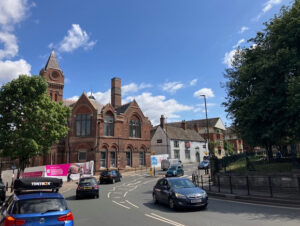
Chesterfield planners have given the go-ahead for changes to the listed town centre Stephenson Memorial Hall and Pomegranate Theatre’s multi-million pound renovation scheme.
The planning committee at Chesterfield Borough Council approved the latest changes to the beautiful Grade 2 listed buildings at the junction of Corporation Street, St Mary’s Gate and Holywell Street, in Chesterfield, during a meeting on July 7 as part of the council’s £11m refurbishment project.
Twelve changes which have now been given ‘retrospective approval’ for the ongoing refurbishment include a revised extension to Station Back Lane, works to the ‘Caretakers House’ and Stage House, new timber studwork lobbies to the upper ground floor level of St Mary’s Gate to provide a second set of fire doors, ventilation ducts, alterations to the original Corporation Street entrance and new lighting and CCTV positions.
Council planning officer Helen Frith said: “There are lots of little changes and lots of different details that are different to what was originally approved but I still feel we are in a position to approve these changes.”
The overall approved scheme includes the refurbishment of the Grade 2 listed Stephenson Memorial Hall including the theatre, museum and art gallery to create an integrated cultural centre with the development of accessible routes and lifts, improved capacity and comfort, a new bar and cafe spaces and improved staff and performer facilities with a greater sense of arrival for visitors to Chesterfield.
Plans were first announced in 2021 following a £20m funding commitment from the Government’s Levelling Up Fund for the council with a portion to be used to deliver the authority’s Revitalising the Heart of Chesterfield Project for improved connections and open spaces with £11m to be used to fund the renovation and remodelling of Stephenson Memorial Hall.
The project also received £695,000 of funding from the Arts Council England’s Capital Investment Programme which is being used to install a ventilation system in the auditorium and to create a new changing places toilet.
Retrospective approvals for the latest new changes to the scheme include the following:
A revised extension to Station Back Lane;
Works to the ‘Caretakers House’ and Stage House Doors;
Improvements for the Corporation Street external door with a new single leaf timber door;
A new flat roof to replace the laundry roof to the east of the Stage House;
New timber studwork lobbies to the upper ground floor level of St Mary’s Gate to provide a second set of fire doors;
The removal and capping of top portions of the roof cowls and for the openings to be insulated internally;
The headroom in the Corporation Street Roof extension is relatively low so some mechanical ventilation ducts and plant need to be accommodated on the flat roof;
New window arrangement to the Corporation Street extension;
An amended arrangement to the original entrance to Corporation Street with the stone surround to the opening to be restored and the cast iron beam to be concealed with a timber painted fascia panel;
Various small external ventilation grilles to be introduced;
Gable end wall and copings to Corporation Street to be amended with a revised design to carefully remove the coping stones top portion of brickwork to the gable and to rebuild the wall to a flat, lower-level wall;
And finally newly proposed external lighting and CCTV positions.
Planning Committee Chairman Ian Callan said that with such a complex project he would always expect there to be things that have to be changed and Cllr Martin Stone added that he expects the council to be absolutely staggered by the planned improvement at the site.
The museum and theatre closed in 2022 to allow preparatory works to begin including the removal of asbestos, ground investigations and a strip-out and the project is expected to be completed in 2026.
The building originally dates back to 1879 and it had been used for lectures, classes and a library before it was sold to Chesterfield Corporation in 1889 and it was extended during the same year to include the theatre which opened in 1898.
In 1949, the building became the first ever repertory theatre to be owned and run by a local council, according to Chesterfield Borough Council.





